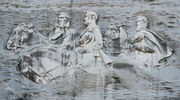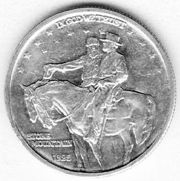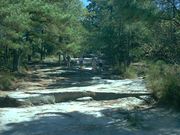Stone Mountain
| Stone Mountain | |
|---|---|
 Overview of Stone Mountain |
|
| Elevation | 1,686 ft (514 m) |
| Prominence | 825 ft (251 m) |
| Location | |
| Location | Stone Mountain, Georgia, USA |
| Range | None |
| Topo map | USGS Stone Mountain, GA |

Stone Mountain is a quartz monzonite dome monadnock in Stone Mountain, Georgia. At its summit, the elevation is 1,686 feet (513 m) amsl and 825 feet (251.5 m) above the surrounding area. Stone Mountain granite extends underground 9 miles (14 km) at its longest point into Gwinnett County. Numerous reference books and Georgia literature have dubbed Stone Mountain as “the largest exposed piece of granite in the world". This misnomer is most likely a result of advertisement by granite companies and early park administration. In actuality, there are larger exposed granite landscapes throughout the world including the Sierra Nevada mountain range in California. Stone Mountain, though often called a pink granite dome, is actually a quartz monzonite rock when described in geologic terms and is therefore not technically granite. Stone Mountain is well-known not only for its geology, but also for the enormous bas-relief on its north face, the largest bas-relief in the world.[1] Three figures of the Confederate States of America are carved there: Stonewall Jackson, Robert E. Lee, and Jefferson Davis.
Contents |
Description
The mountain is more than five miles (8 km) in circumference at its base. The summit of the mountain can be reached by a steep walk-up trail, which starts near the Confederate Hall and West gate entrance. Alternatively, the summit is reachable by the Skyride.
The top of the mountain is a landscape of bare rock and rock pools, and it provides views of the surrounding area including the skyline of downtown Atlanta, often Kennesaw Mountain, and on very clear days even the Appalachian Mountains. On some days, the top of the mountain is shrouded in a heavy fog, and visibility maybe limited to only a few feet. The clear freshwater pools of the summit form by rainwater gathering in eroded depressions, and are home to unusual clam shrimp and fairy shrimp. The tiny shrimp appear only during the rainy season, and it is believed that the adult shrimp die when the pools dry up, leaving behind eggs to survive until the next rains.

The mountain's lower slopes are wooded. The rare Georgia oak was first discovered at the summit, and several specimens can easily be found along the walk-up trail and in the woods around the base of the mountain. In the fall, the extremely rare Confederate Yellow Daisy (Helianthus porteri) flowers appear on the mountain, growing in rock crevices and in the large wooded areas.
Geology
Stone Mountain is a pluton, a type of igneous intrusion. Primarily composed of quartz monzonite, the dome of Stone Mountain was formed during the formation of the Blue Ridge Mountains, part of the Appalachian Mountains. It formed as a result of the upwelling of magma from within the Earth's crust. This magma solidified to form "granite" within the crust five to ten miles below the surface.
The "granite" is composed of quartz, feldspar, microcline and muscovite, with smaller amounts of biotite and tourmaline. Embedded in the "granite" are xenoliths or pieces of foreign rocks entrained in the magma.
The "granite" intruded into the metamorphic rocks of the Piedmont region during the last stages of the Alleghenian Orogeny, which was the time when North America and North Africa collided. Over time, erosion eventually exposed the present mountain of more resistant igneous rock, in processes similar to those that have exposed Devils Tower National Monument in Wyoming.
The mountain's composition was described by one political commentator—and used as such as a simile for racial segregation in the 1950s—as "soft, exfoliating rock [which] turns to dust under the hammer."[2]
History
Carving

The largest bas relief sculpture in the world, the Confederate Memorial Carving depicts three Confederate leaders of the Civil War, President Jefferson Davis and Generals Robert E. Lee and Thomas J. "Stonewall" Jackson (and their favorite horses, "Blackjack", "Traveller", and "Little Sorrel", respectively). The entire carved surface measures 3 acres (12,000 m2), about the size of three football fields. The carving of the three men towers 400 feet (120 m) above the ground, measures 90 by 190 feet (58 m), and is recessed 42 feet (13 m) into the mountain. The deepest point of the carving is at Lee's elbow, which is 12 feet (3.7 m) to the mountain's surface.
In 1912, the carving existed only in the imagination of Mrs. C. Helen Plane, charter member of the United Daughters of the Confederacy (UDC). The Venable family, owners of the mountain, deeded the north face of the mountain to the UDC in 1916. The UDC was given 12 years to complete a sizable Civil War monument. Gutzon Borglum was commissioned to do the carving, and he with the Stone Mountain project.
Borglum abandoned the project in 1923 (and later went on to complete Mount Rushmore). American sculptor Augustus Lukeman continued until 1928, when further work stopped for thirty years.
In 1958, at the urging of Governor Marvin Griffin, the Georgia legislature approved a measure to purchase Stone Mountain for $1,125,000. In 1963, Walker Hancock was selected to complete the carving, and work began in 1964. The carving was completed by Roy Faulkner, who later operated a museum (now closed) on nearby Memorial Drive commemorating the carving's history. The carving was considered complete[3] on March 3, 1972.
Stone Mountain is where the second KKK was formed in 1915. It has also been used as a site for Klan rallies throughout the years.
On many summer nights the mountain is home to the Laser show Spectacular which uses popular and classic music to entertain park guests with a large fireworks and laser light display. The American Civil War is acknowledged, but the strength of a reunited country concludes the message, with Sandi Patti singing the Star Spangled Banner. There are still old favorites included with the show, “Devil Went down to Georgia”, “Celestial Soda Pop”, and “Trilogy”. There have been several additions to the show for its 25th anniversary.
Carving and the Ku Klux Klan

Ku Klux Klan activities at Stone Mountain are deep-rooted, although the original conception of the memorial pre-dates the 1915 revival of the Klan. The revival of the Ku Klux Klan was emboldened by the release of D. W. Griffith's Klan-glorifying film The Birth of a Nation,[4] and by the lynching of Leo Frank, who was convicted in the murder of Mary Phagan.[5] On November 25, 1915, a group of robed and hooded men met at Stone Mountain to create a new incarnation of the Klan. They were led by William J. Simmons, and they included a group calling itself the Knights of Mary Phagan. A cross was lit, and the oath was administered by Nathan Bedford Forrest II, the grandson of the original Imperial Grand Wizard, Gen. Nathan B. Forrest, and was witnessed by the owner of Stone Mountain, Samuel Venable.
Fundraising for the monument resumed in 1923, and in October of that year, Venable granted the Klan easement with perpetual right to hold celebrations as they desired.[6] Because of their deep involvement with the early fund-raising and their increasing political clout in Georgia,[7] the Klan, along with the United Daughters of the Confederacy, were able to influence the ideology of the carving, and they strongly supported an explicitly Confederate memorial. Of the $250,000 raised, part came directly from the Ku Klux Klan [7] but part came from the federal government, which in 1924 issued special fifty-cent coins with Robert E. Lee and Stonewall Jackson on them.

Dr. Martin Luther King, Jr. mentioned the monument in his 1963 "I Have a Dream" speech in Washington, D.C., when he said "let freedom ring from Stone Mountain of Georgia!"[3] Ironically, granite suppliers in Georgia sent samples cut from Stone Mountain to the Martin Luther King, Jr. Memorial Foundation to be considered for use in a planned monument in King's honor; the Foundation later chose to use granite imported from China.[4]
Aviation Accidents on Stone Mountain
According to George Weiblen's annotated calendar for Monday, May 7, 1928: "Mail plane crashed on mountain at 8:00 P.M."
Around dusk on September 16, 2003, a small airplane crashed into the back of the mountain, a remote cliff area which is not normally accessible.[8] The pilot, the airplane's only occupant, was confirmed dead. Although the official accident report notes no probable cause, a witness stated that the pilot threatened on multiple occasions to commit suicide by flying into Stone Mountain. Firefighters took the Skyride up and then rappelled down to the site of the plane's wreckage.
Present




Stone Mountain Park, which surrounds the Confederate memorial, is owned by the state of Georgia and managed by the Stone Mountain Memorial Association, a Georgia state authority. The Herschend Family Entertainment Corporation currently has a long-term contract to operate park attractions while the Stone Mountain Memorial Association retains ownership and the right to reject any project deemed unfit.
During the 1996 Summer Olympics, Stone Mountain Park provided venues for Olympic events in tennis, archery and track cycling. The venues for archery and cycling were temporary and are now part of the songbird and habitat trail.[9]
Places of interest
Confederate Hall, operated directly by the Stone Mountain Memorial Association or SMMA, is a museum that educates students and park guest on the geology and ecology of Stone Mountain as well as historical aspects of the area. A small theater shows a historical documentary about the Civil War in Georgia called "The Battle for Georgia".
The education department is host to thousands of students each school year teaching the subjects of history, ecology, and history. Classes are designed to meet the Georgia Performance Standards and the North American Association for Environmental Education guidelines.
The Antebellum Plantation and Farmyard is an open air museum composed of 19 historic buildings, built between 1790 and 1875, which have been re-erected to the site to represent a pre-Civil War Georgia plantation. The historic houses have been furnished with an extensive collection of period furniture and decorations. The farm features live animals that guests can pet.
Crossroads is a recreation of an 1872 southern town with several attractions including a modern 4-D movie theater, an adventure mini-golf course, a duck tour ride, stores and restaurants. Crafts demonstrators include glass blowing and candy making. Other attractions in this area include:
Scenic Railroad
Main article:Stone Mountain Scenic Railroad
The Great Barn is a children's activity area that features 65 interactive games, climbing structures, trampoline floors, slides and more.
Sky Hike is a family ropes adventure course. Guests can choose their own path and level of challenge.
Stone Mountain Trails
- Walk Up Trail: A 1.3-mile (2.1 km) trail to the top of Stone Mountain ascending 786 ft (240 m) in elevation to a height of 1,686 ft (514 m) Spectacular panoramic views and cool winds await tired hikers at the top. This trail is steep and very slippery when wet. Use caution when hiking. Dogs not allowed.
- Cherokee Trail: A 5-mile (8.0 km) National Recreation Trail, the Cherokee Trail loops around the mountain base, with a mile section going up and over the west side of the mountain (crosses Walk Up Trail). Primarily passes through an oak-hickory forest, but views of the lakes, streams, and mountain are common. map of Cherokee Trail
- Nature Garden Trail: A scenic 3/4 mile loop trail through a mature oak-hickory forest community. Excellent for viewing shade-loving native plants. A small garden with interpretive native plant signs is a the entrance to trail.
- Songbird Habitat Trails: Two loop trails each running one mile (1.6 km) in length.The field trail is an excellent birding spot and the woodland trail provides shade and numerous native plants. Dogs not allowed.
Attractions
The Park features several attractions that are operated by Herschend Family Entertainment Corp., and include:
The famous Stone Mountain Laser Show Spectacular is a colorful lightshow of lasers projecting moving images of the Deep South as well as Georgia history onto the Confederate carving on the side of the mountain. The laser show is accompanied by a compilation of themed musical works. At dusk hundreds of onlookers sit upon the grassed hill celebrating their American and Southern heritages.
The Skyride is a Swiss-built cable car to the summit of the mountain which passes by the carving on the way up.
The Riverboat offers a scenic cruise aboard a reproduction Mississippi riverboat on 363 acre (147 ha) Stone Mountain Lake.
Other attractions include:


- A 732-bell carillon that originated at the 1964 New York World's Fair, provides a daily concert.
- A covered bridge, dating from 1892, which originally spanned the Oconee River in Athens, Georgia.
- A grist mill, dating from 1869 and moved to the park in 1965.
Transmitter


The short broadcast tower on the top of the mountain transmits two non-commercial stations: television station WGTV channel 8, and weatheradio station KEC80. FM radio station WABE was located on this tower from 1984 until 2005, when it was required to relocate to accommodate WGTV's digital conversion.
See also
- List Of Colossal Sculpture In Situ
References
- ↑ "Stone Mountain." georgia.gov, retrieved February 2007.
- ↑ "The Counter Revolution" OpEd by Howell Raines, The New York Times, January 31, 2010 (in print Feb. 1, 2010, p. A19 NY ed.).
- ↑ "Stone Mountain History", stonemountainpark.org; retrieved February 2007
- ↑ A Painful Present as Historians Confront a Nation's Bloody Past
- ↑ Wade, Wyn Craig. The Fiery Cross: The Ku Klux Klan in America. New York: Simon and Schuster (1987); Horn, Stanley F. Invisible Empire: The Story of the Ku Klux Klan, 1866-1871, Patterson Smith Publishing Corporation: Montclair, NJ, 1939.
- ↑ [1] Sims, Patsy. "The Klan". University Press of Kentucky (1978).
- ↑ 7.0 7.1 [2] "Stone Mountain Carving" from About North Georgia, http://ngeorgia.com
- ↑ NTSB Accident Report: Stone Mountain, 16 September 2003.
- ↑ Driving Map: Stone Mountain Park (2009). Pamphlet. Stone Mountain, Georgia: Stone Mountain Park.
Further reading
- Deborah Yost (1997). Georgia's Stone Mountain Park. Aerial Photography Services, Inc. ISBN 1-880970-11-2.
- Golden Ink (1994–2003). About North Georgia: Stone Mountain. Retrieved July 29, 2005.
- James W. Loewen (1999). Lies Across America: What Our Historic Sites Get Wrong. New Press. ISBN 1-56584-344-4.
- Stone Mountain Memorial Association (2005). Stone Mountain: Ecosystem. Retrieved July 30, 2005.
- United Daughters of the Confederacy(2007). Georgia Division, United Daughters of the Confederacy.
External links
 Media related to Stone Mountain at Wikimedia Commons
Media related to Stone Mountain at Wikimedia Commons- Atlanta, Georgia, a National Park Service Discover Our Shared Heritage Travel Itinerary
- City of Stone Mountain, Georgia, from the City of Stone Mountain*Main Street Stone Mountain
- Stone Mountain article, from the New Georgia Encyclopedia
- Stone Mountain Park and City Information*Stone Mountain Park Photos
- Stone Mountain Park website, from the state authority that owns the park
- View from the top of Stone Mountain looking Northeast (1934) and Granite Quarry at Stone Mountain (1913) from the Georgia Geological Survey photographs in the collection of the Georgia Archives.
|
||||||||
|
|||||||||||||||||||||||||||||||||||||||
|
|||||||||||||||||
|
|||||||||||||||||||
